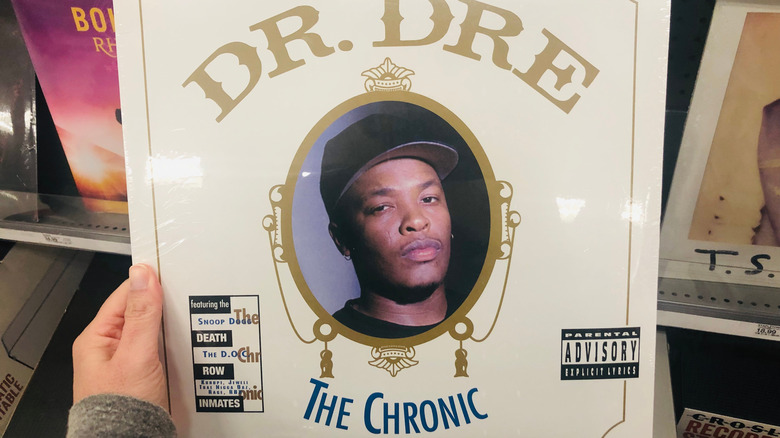How Dr. Dre's The Chronic Changed Hip-Hop Forever
On December 15, 1992, rapper Dr. Dre — born Andre Romelle Young — released his first solo album titled "The Chronic." He had just left the group N.W.A. that same year and decided to partner with Suge Knight to establish Death Row Records, and the release of his solo work catapulted the record label into immediate success, but he struggled to get there. In a 1993 interview, Dr. Dre stated. "I went to a lot of record label companies, tried even to get a little production work to pay for rent and shoes. But nobody wanted to take a chance on me."
"The Chronic" is said to have redefined hip hop music, and the track "Nuthin' But a G Thang" became one of the songs that dominated the '90s hip hop genre, per The Daily Beast. The album peaked at the No. 3 spot on the Billboard 200 and earned Dr. Dre his first Grammy Award in 1993 for Best Rap Solo Performance for the song "Let Me Ride" (via Grammy). Decades after its initial release, "The Chronic" is still celebrated as one of the most important hip-hop albums of all time, and it changed hip-hip in more ways than one.
It popularized G-funk
Before the release of "The Chronic," rap music mostly consisted of harsh beats that accompanied often violent lyrics. Dr. Dre's new solo effort popularized the hip-hip sub-genre G-funk (or gangsta funk), which consisted of grooves, samplings from '70s funk tunes, and hooks that appealed to a broader audience, as reported by Britannica. G-funk became associated with West Coast rap music, and with the added melodies, it was more acceptable for radio play than other abrasive rap music that was deemed too controversial.
Barry Ashworth of the English band Dub Pistols described "The Chronic" as a "genre-changing moment that brought us the sound of G-funk and changed the way rap music was perceived forever. It's a timeless classic" (per NME). Rapper Kanye West also shared the same opinion and stated that Dr. Dre's "The Chronic" is "the benchmark you measure your album against if you're serious." Other artists whose music is heavily influenced by G-funk include Snoop Dogg, Coolio, Eazy-E, and Tupac.
The Chronic made West Coast rap a phenomenon
West Coast rap originated in Los Angeles in the 1980s when a young disc jockey named Alonzo Williams formed the hip-hop group World Class Wreckin' Cru that included Dr. Dre. The group is considered the pioneers of West Coast rap, but it wasn't until the release of "The Chronic" that the hip-hop genre became a phenomenon. "We all were key players in the early stages of West Coast hip-hop. I probably was the most keyest of all," Williams said in an interview with the Los Angeles Times.
The release of "The Chronic" propelled West Coast hip-hop to new heights, the genre dominated radio waves in the mid-'90s, and it paved the way for other rappers to enter the music business. In the years following, several West Coast hip-hop albums were released including Warren G's "Regulate," Tupac's "Me Against the World" and "All Eyez on Me," Xzibit's "40 Dayz & 40 Nightz," and many others.
The use of live instrumentation
What makes "The Chronic" different from other hip-hop albums is the use of live instrumentation, which is not something new, but was not a popular choice in rap music then. In an interview with Vibe, per Hip Hop DX, Dr. Dre said that it was one of the reasons why record labels turned him down back then. "Everybody was slamming doors on me, talking about, 'This isn't hip-hop; you're using live instruments.' It had me second-guessing myself," he recalled. As a matter of fact, Dr. Dre wasn't even sure what he was doing at that time and even asked rapper Nate Dogg, "Is this s**t good or not?"
His decision to widely use live instrumentation was a success, as evidenced by the legacy of "The Chronic." Although sampling is part of hip-hop music, it's quite common to use live instruments today, as reported by DJ Booth. Hip-hop producer Dirty Dunnz had this to say about using loops and samples versus live instrumentation: "In the past, all I had to do was dig in the crates, fin an obscure sample from overseas, chop it up, and put some ill drums with a walking bassline behind it to make a hot beat." But some listeners gave him feedback that the track "sounds unfinished." "As a producer, live instrumentation makes you more competitive in a world full of trap producers," he said.



